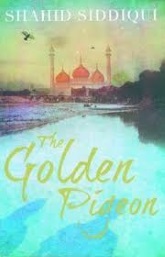The Golden Pigeon
Shahid Siddiqui

Paperback: 200 pages Publisher: Harper Collins India(2014)
|
The Golden Pigeon, Shahid Siddiqui’s debut work of fiction, is best described not so much as a historical novel but as a historical fantasy. Using the contradictions faced by Muslims in post-Partition India as the foundation of his story, the author has layered in elements of magic realism: his is a world where jinns have the power to aid or obstruct events, great Mughal kings come to life to hold court in ancient tombs and impossibilities turn into possibilities—even palpable realities. Shiraz and Aijaz are Rushdie’s “midnight’s children”. Aijaz is born on the night of 14th August 1947 and Shiraz fifteen minutes past midnight on the 15th. Their birth coincides with the birth of India and Pakistan as two separate nations. As circumstances turn increasingly precarious for the Muslims staying back in India, Azizuddin Khan, the father of the two boys, decides to leave Delhi to create a new life for himself in Pakistan. It is an idea which his wife, Hamida Begum, strongly resists. She is a true descendant of the Mughals, being the great granddaughter of Kulsum Zamani Begum – the daughter of the last Mughal Emperor. Like her mother, Qudsia Begum, Hamida Begum is a loyalist and opposed to Jinnah’s idea of a divided India. Early one morning, under duress, she accompanies her husband to the Old Delhi railway station to escape to the safety of Pakistan. While Azizuddin steps out to buy tickets for them with Aijaz asleep on his shoulder, Hamida Begum rushes out of the building holding her younger son “as though possessed by a jinn.” Dodging rioting mobs running berserk in the city, she reaches her mother’s home in the street of Ballimaran in Chandni Chowk, a well-known area in Old Delhi. Qudsia Begum is known for—and often teased about—hobnobbing with her jinns. Hamida Begum pursues higher education and eventually becomes a social activist. Her husband emerges as a minister in his country of refuge. Once communication is finally re-established between husband and wife, efforts at reunion are thwarted time and again by turmoil in both countries, made worse by indications of war. Hamida Begum is upset with her mother; she holds her responsible for conspiring with her jinns to create adverse conditions. Only Shiraz is pleased by these constant interruptions since he considers himself a patriotic Indian. He is fervidly against migrating to Pakistan to join his father and brother. Whenever his neighbour, Brij Behari, a passionate pigeon flyer, teases him as his “little Pakistani”, Shiraz retorts, “I am no Pakistani; I hate Pakistan.” Through Brij Behari Shiraz learns that he shares his name “Shiraz” with a breed of famous homing pigeons (from Shiraz in Iran) after which his father named him. Pigeons run as a motif throughout the novel. At the time of circumcision, to distract young Muslim boys from the trauma of the ceremony, adults would point to the sky to show them a “golden pigeon”. The moment the child looked up, the foreskin would be quickly dislodged. The golden pigeon therefore symbolizes a new phase in the young boy’s life signifying both physiological and psychological changes. But it is not simply a metaphor. Its real significance becomes apparent when, at the age of nineteen Shiraz is falsely implicated in the murder of his friend, Brij Behari—also the uncle of his beloved Anu whom he wants to marry. Trapped by their different religious identities, both the lovers know marriage is impossible—that it might lead to communal riots in the city. Riots follow anyhow in the wake of rumours spread about Shiraz by hostile Hindus. At this juncture Qudsia Begum invokes her jinns—her Mughal ancestors—to help her grandson cross the border into Pakistan. The two parts of the novel are different stylistically as well as thematically. The first half more or less follows the conventions of a realist novel. Elements of magic realism are introduced in part two, when the jinns appear in the form of Shiraz’s Mughal ancestors. The texture of the prose and the author’s philosophy, however, are very different from Rusdhie’s whose novels are set in the same era and are well known for their magic realism. Simplicity of style and childlike innocence in the tone mark Siddiqui as quite distinct from other writers writing about the Partition. The beginning is brilliantly visual with detailed descriptions of the lanes and by-lanes of old Delhi or Shahjahanabad: the culture ruled by disciples of popular poets such as Ghalib, Mir and Momin; an undiscovered MF Hussain distributing his paintings in the street for free; special days of feasting on nahari and nan. The flow too is much smoother than in the latter half. The language is clear and persuasive, the plot credible and engrossing. The latter half seems rushed in comparison. Too much is packed into each chapter. As a consequence, certain actions seem arbitrary. For instance, the reader never learns why Shiraz has to experience what he does to cross over into Pakistan and then to return to India or why he can never reveal his strange secret to anyone. The part where he has to spend about a year in jail also seems hackneyed and predictable. Siddiqui has given his fantasy a happy, neatly tied-up ending, taking some of the edge off what is otherwise an edgy subject. Reviews
|
